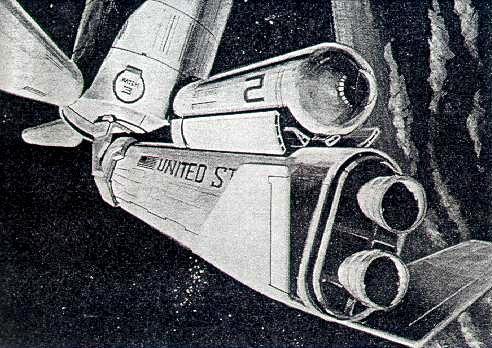
Home - Search - Browse - Alphabetic Index: 0- 1- 2- 3- 4- 5- 6- 7- 8- 9
A- B- C- D- E- F- G- H- I- J- K- L- M- N- O- P- Q- R- S- T- U- V- W- X- Y- Z
Shuttle FR-3

Shuttle FR-3
Credit: NASA
Status: Study 1969. Thrust: 30,243.00 kN (6,798,896 lbf). Gross mass: 2,557,880 kg (5,639,160 lb). Height: 86.00 m (282.00 ft). Diameter: 11.19 m (36.71 ft).
General Dynamics received a $0.15-million Phase-A extension from NASA/Marshall to further study its shuttle concepts. The Triamese design was abandoned in September 1969 after more detailed analysis indicated that the development cost showed no considerable advantages vs. traditional two-stage systems. It had proven difficult to have one aerodynamic shape serve both as booster and orbiter; too many compromises had to be made. The designers then tried to "stretch" the Triamese orbiter but this, in turn, reduced the design commonality and hence cost savings. The company finally settled for a similar "FR-3A" two-stage design with V-tails to provide hypersonic roll control and aerodynamic stability. The booster/orbiter staging point was at 56.7km altitude and 193 seconds after launch when the vehicles were flying at 3325 meters/second. The straight-sided bodies were designed to accommodate cylindrical propellant tanks efficiently. Variable geometry switch-blade wings would still be used for subsonic flight and landing. This would have reduced the thermal protection system requirement (GD was the only company that still proposed a "hot structure" metallic TPS at the end of Phase A) . But the General Dynamics concept also had the same problem as MSC's/North American's DC-3 design since it had comparatively poor re-entry cross range capabilities
Stage Data - Shuttle FR-3
- Stage 1. 1 x Shuttle FR-3-1. Gross Mass: 2,169,691 kg (4,783,349 lb). Empty Mass: 234,467 kg (516,911 lb). Thrust (vac): 30,088.430 kN (6,764,148 lbf). Isp: 442 sec. Burn time: 275 sec. Isp(sl): 392 sec. Diameter: 11.19 m (36.71 ft). Span: 25.70 m (84.30 ft). Length: 71.80 m (235.50 ft). Propellants: Lox/LH2. No Engines: 15. Engine: SSME Study. Status: Study 1969 October. Comments: Trapezoidal lifting body configuration.
- Stage 2. 1 x Shuttle FR-3-2. Gross Mass: 388,189 kg (855,810 lb). Empty Mass: 130,159 kg (286,951 lb). Thrust (vac): 4,549.049 kN (1,022,667 lbf). Isp: 459 sec. Burn time: 251 sec. Isp(sl): 359 sec. Diameter: 7.46 m (24.47 ft). Span: 21.75 m (71.35 ft). Length: 54.57 m (179.03 ft). Propellants: Lox/LH2. No Engines: 2. Engine: SSME Study. Status: Study 1969 October. Comments: Trapezoidal lifting body configuration. Cross range 2419 km.
Family: orbital launch vehicle, Winged. Country: USA. Engines: SSME Study. Stages: Shuttle FR-3-1, Shuttle FR-3-2. Agency: Convair.
Back to top of page
Home - Search - Browse - Alphabetic Index: 0- 1- 2- 3- 4- 5- 6- 7- 8- 9
A- B- C- D- E- F- G- H- I- J- K- L- M- N- O- P- Q- R- S- T- U- V- W- X- Y- Z
© 1997-2019 Mark Wade - Contact
© / Conditions for Use